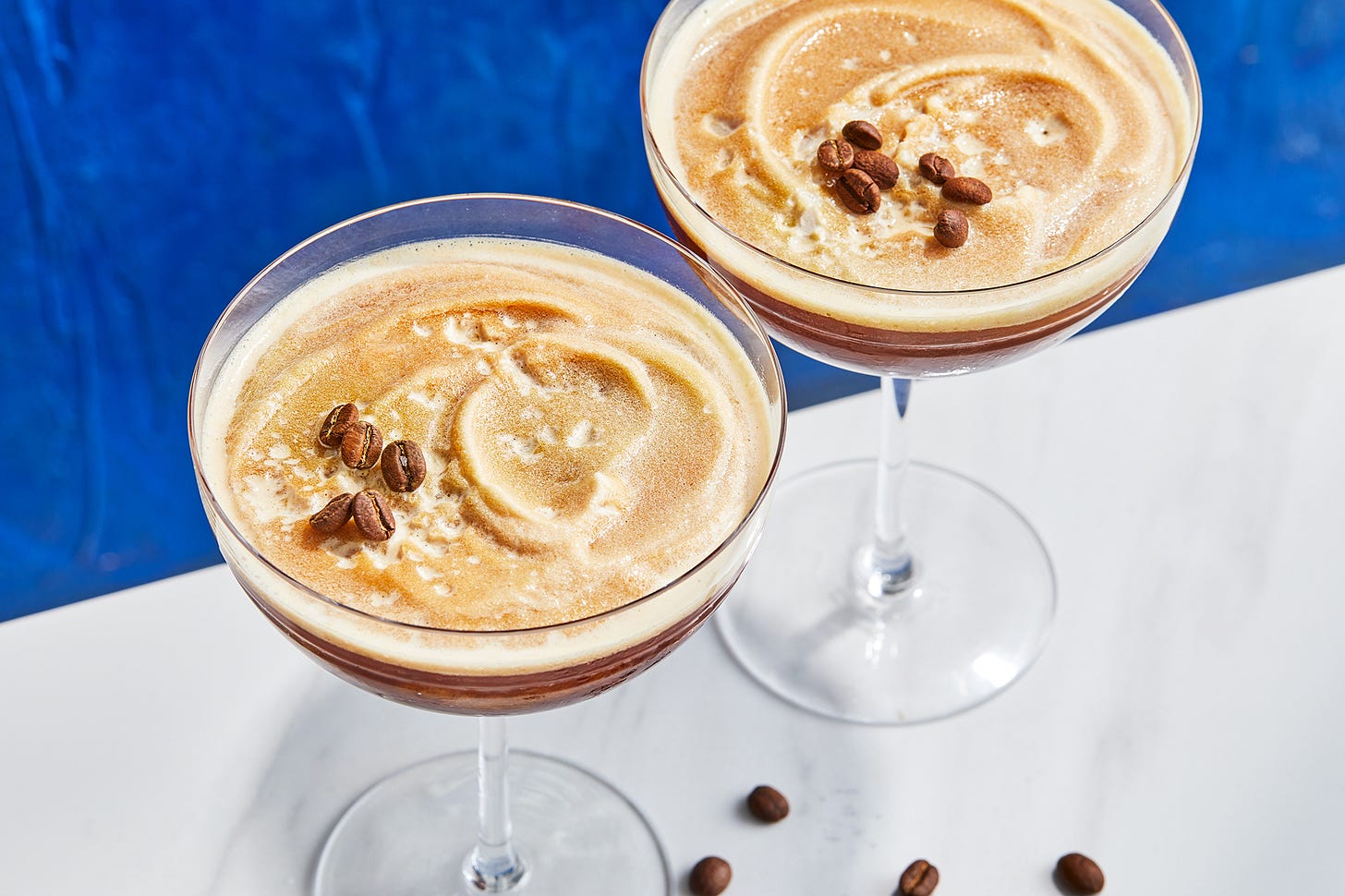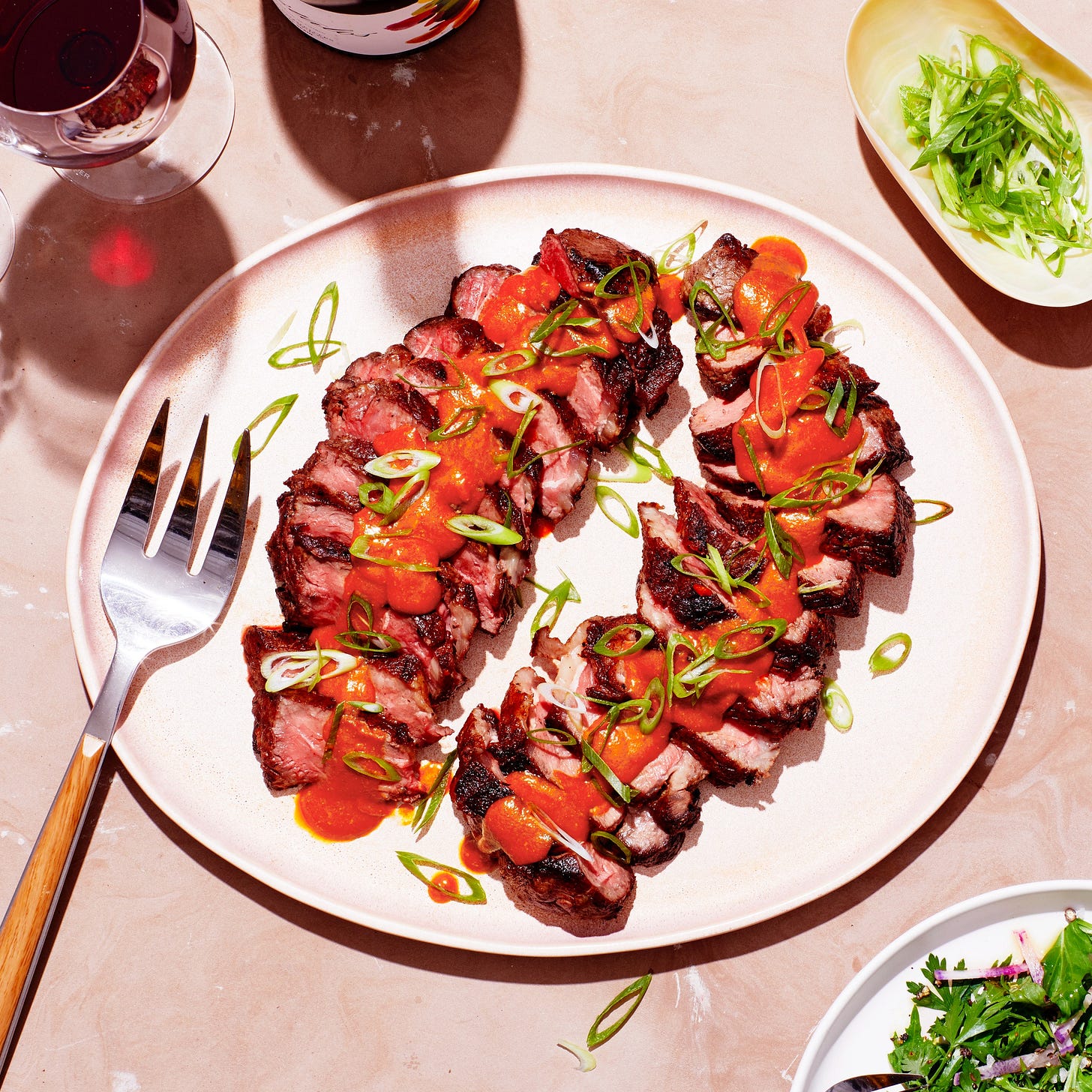Micah's Read of the Week, Vol. 104
The True Costs of Inflation, How Dinner Parties Became the Fuzzy Blanket of Adulthood, a dinner party-ready Recipe Corner, New Yorker Cartoon of the Week, and more.
Hello, and welcome to Micah’s Read of the Week.

This is a newsletter filled with things Micah Wiener finds interesting. Check out the archive of previous newsletters here.
The True Costs of Inflation in Small-Town Texas
When R-BBQ had to cut its hours and reduce its portions, the effects rippled through the community.
Here’s a focused story about a big picture issue, with a great lede:
One Sunday a couple of months ago, Robert Rodriguez thought he’d try something new at R-BBQ, the restaurant he owns in Sabinal, on the southwestern edge of the Texas Hill Country. Wholesale prices were rising—they’d been rising since the covid-19 pandemic began—and now a box of a hundred and eighty eggs, which had cost around eight dollars when he opened the restaurant, in 2001, was nearly fifty. Rodriguez thought of himself more as a cook than as a businessman, but he had been at this long enough to know when his costs and his revenue were out of alignment. He considered raising prices, but the thought made him uneasy; many of his customers were high-school students, or unemployed, or retirees on fixed incomes. “I was thinking that they wouldn’t want to pay more—they’d rather eat less,” he told me recently, when we spoke at his restaurant. “So I started doing the shrinkflation.” He scrambled one egg instead of two for a breakfast taco, and started making smaller pancakes.
The change didn’t go unnoticed. One of Rodriguez’s regular customers scolded him, saying that his patrons loved the big tacos. Rodriguez, who was behind the griddle that day, as he is most Sundays, decided that the experiment was a failure. “The next taco that came out was a two-egg taco,” he said. He kept the portions large and the prices low, but soon, he knew, something would have to give.
Restaurants have been hit hard by inflation—the price of food, particularly meat, has risen more than the overall consumer-price index—and barbecue restaurants are among the hardest hit of all.
The price of beef spiked twenty percent during the pandemic’s first year, owing to supply-chain disruptions and covid outbreaks in meatpacking plants. “We couldn’t get product. And when we could we paid a premium. Brisket went from one sixty-nine a pound to seven,” Rodriguez said. “And I don’t believe it’ll ever go back down that far.”
When gas prices spiked earlier this year, Rodriguez’s suppliers added fuel surcharges to his bills.
He felt it at home, too, how everything on his grocery list—rice, dried beans, barbacoa—was getting pricey. Sometimes he’d joke about there being a new tax on the Mexican American diet. “You know that stuff that used to be cheap?” he said. “Well, it ain’t cheap anymore.”
With labor shortages and increased expenses, everything about running the business is in flux.
“My drive is to keep this going, because my dad sunk his savings into it,” Rodriguez said. “But there are days when I feel like, Why am I doing this?”
“Like, man, am I losing it? I’ve put too much work in here. I’ve worked so hard to want people to come in here. And now I have it, and I’m having to shut the doors.”
5-star review of the week
Another closed deal, another 5-star review for your favorite Certified Mortgage Advisor. Peter put in offers on several homes, even getting under contract multiple times. I was with him every step of the way, and he rewarded me with a 5-star review on google.
Slightly edited for clarity:
I have dealt with several lenders during the process of purchasing my home, but I choose to go with Hometown Texas Lending because I fully trust their expertise and knowledge. They kept me informed and provided updates every step of the way. Micah, the loan officer, went above and beyond in finding the best options and mortgage rates for me. His team is very professional and I can't thank them enough. If I ever purchase another home, they will be my go-to Lender.
Thank you Hometown Texas Lending!
Thank you, Peter. Get started today with your home search. Schedule a free consultation with me now at micahwiener.com.
New Yorker Cartoon of the Week
How Dinner Parties Became the Fuzzy Blanket of Adulthood
They used to be all about class flexing. Now we gather for comfort.
Dinner parties offer a simple way to connect with others. But historically, dinner parties haven’t always been about peace and joy. In fact, while people have always gathered to share meals, the dinner party once was a significant source of class anxiety.
After World War II, the rapidly expanding American middle class couldn’t necessarily afford household servants, but they could buy fancier things like china, according to sociologist Alice Julier, the author of Eating Together: Food, Friendship, and Inequality. Dinner parties provided an opportunity to demonstrate one’s upward mobility and social graces and to connect with people in a more opportunistic way. It was more networking than relaxing; people might have invited their bosses over for dinner, for instance. The motivations of a postwar dinner party were “very rooted in the Western social class model of aspiration,” Julier says.
But after the war, the middle class became more prosperous, and people’s reasons for inviting folks to dinner changed. “Every single person, no matter what they did, said it was about ‘making people comfortable,’” she says. “That’s not what [legendary etiquette expert] Emily Post meant when she talked about hospitality, and that, to me, is the key to the modern iteration. There are very few spaces left where we can have that kind of comfort with one another.”
So what’s the best way to throw a dinner party?
Setting an intention for the meal creates comfort for guests and hosts alike, says Priya Parker, author of The Art of Gathering: How We Meet and Why It Matters. “‘Purpose’ is just a different way of saying, ‘What is the need around which I want to bring people together?’” she says. Maybe it’s to welcome a new friend to the neighborhood, celebrate an accomplishment, try a new recipe, or mark a community ritual together.
A purpose “allows people some amount of shared context, a shared story, a shared way of knowing what to talk about,” she says. It allows people to connect in a meaningful way, and the added context helps guests settle into the evening and enjoy the company of others.
That’s not to say the food doesn’t matter.
The ultimate comfort of a dinner party is that everyone knows the intention will be backdropped by a central activity: eating dinner.
So, let’s eat. Today’s Recipe Corner is a ready-made dinner party menu. Bon Appetit.
Recipe Corner
Frozen Salted Espresso Martinis
The espresso martini is the drink of 2022. Stop fighting it. Let’s make a frozen one.
1 ⅔ cups brewed espresso, at room temperature
6 tablespoons (3 ounces) coffee liqueur (such as Kahlúa)
¼ cup (2 ounces) vodka
1 tablespoon simple syrup
Flaky sea salt (such as Maldon)
6 coffee beans
Pour espresso into an ice cube tray. Freeze until solid, about 4 hours.
Process espresso ice cubes, coffee liqueur, vodka, and simple syrup in a blender until smooth, about 1 minute. Pour evenly into 2 chilled coupe martini glasses; garnish each with a pinch of sea salt and 3 coffee beans. Serve immediately.
Strip Steak With Umami Butter Sauce
We are grilling steaks with an espresso martini in hand this weekend. There is nothing that can stop me.
2 1"-thick New York strip steaks (about 12 oz. each)
Kosher salt
2 Tbsp. extra-virgin olive oil or vegetable oil
5 Tbsp. unsalted butter, cut into pieces, divided
2 Tbsp. white or yellow miso
½ cup Sriracha
2 scallions, thinly sliced
Heat grill. When grill is very hot, cook steaks, turning every 2 minutes or so, until deeply browned and an instant-read thermometer inserted into thickest part registers 120° for medium-rare (internal temperature should climb to about 130° as steaks rest), 8–10 minutes. Transfer steaks to a wire rack set inside a rimmed baking sheet and let rest 10 minutes.
Meanwhile, melt 1 Tbsp. butter in a small saucepan over medium heat. Add miso and cook, stirring and scraping bottom of pan constantly, until miso darkens a few shades and smells very toasty and nutty (it will stick to pan), about 4 minutes. Pour in ¼ cup water and whisk until incorporated, scraping bottom of pan to release any browned bits. Add Sriracha and remaining 4 Tbsp. butter; cook, whisking constantly, until butter is melted and sauce is smooth. Season with salt. If your miso is a bit lumpy, use an immersion blender).
Transfer steaks to a cutting board and slice against the grain. Arrange on a platter and spoon some butter sauce over; top with scallions. Serve remaining butter sauce alongside.
Eggplant Bread Salad
Guess what? In addition to peak tomato szn, it’s peak eggplant szn.
1 cup bite-size pieces pita bread
1 teaspoon extra-virgin olive oil
10 ounces tomatoes, cut into bite-size pieces (or halved, if using cherry tomatoes)
1/2 teaspoon fine sea salt or table salt, plus more as needed
Vegetable oil, for deep-frying
1 medium eggplant (about 12 ounces), trimmed and diced into 1-inch cubes
3 tablespoons fresh lemon juice
2 tablespoons tahini
2 scallions, thinly sliced
1 green chile, such as jalapeño chile pepper or anaheim, thinly sliced
Leaves from 3 sprigs fresh mint, finely chopped
Make the salad: Position a rack in the middle of the oven and preheat to 350 degrees.
Arrange the bread on a large, rimmed baking sheet, drizzle with the olive oil and toss to combine. Bake for 15 to 20 minutes, until crisp but not browned. Remove from the oven and set aside.
While the pita chips are baking, place the tomatoes in a large colander set over a bowl and sprinkle with the salt. Set aside for at least 20 minutes, tossing occasionally, to let the juices drain into the bowl.
Meanwhile, in a large, heavy pan or Dutch oven over medium high heat, add enough oil to come 3 inches up the sides and heat until it registers 350 degrees on an instant-read thermometer or until a morsel of bread immediately rises to the surface and bubbles vigorously when dropped in. Line a large plate with paper towels or clean kitchen towels and keep near the stove.
Working in batches if necessary, fry the eggplant pieces until uniformly golden brown, 5 to 8 minutes. Use a slotted spoon to transfer the eggplant to the towel-lined plate and sprinkle with salt.
Measure 2 tablespoons of drained tomato juice into a small bowl. Add the lemon juice, tahini and a pinch of salt and stir to combine.
Transfer the tomatoes to a serving bowl and add the fried eggplant, scallions, chile, mint and pita chips. Drizzle with the tahini sauce and toss to combine. Let the salad sit for 5 to 10 minutes to let the bread absorb the dressing, then serve.
Did Micah practice yoga this weekend?
Yes. Twice. 60 minutes Saturday and Sunday at Searsana Dripping Springs.
That’s 27 in-person weekend classes in 29 weeks this year.
Big announcement next week regarding the launch of Micah’s Yoga Club. Don’t miss it.
More Micah
Podcasts: Mind of Micah, Back Door Cover, Too Much Dip
Twitter: @micahwiener & @producermicah (Why two twitters? It’s a long story)
Homebuying consultations: savewithmicah.com
Instagram: @micahwiener
LinkedIn: @micahwiener
TikTok: @mortgagemicah
Peloton: #badboysofpelly @micahwiener
Email: micahwiener@me.com
NMLS #2090158, equal housing lender.








